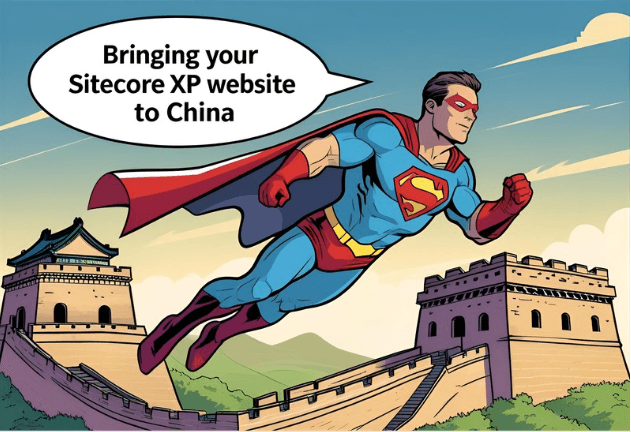Expanding your digital presence into China is an exciting step – the market is vast, dynamic, and digitally advanced. But if you run your website on Sitecore XP, you’ll quickly realize that deploying to China is not as straightforward as replicating your Western setup.
This post explores the technical and regulatory realities of running a Sitecore XP-powered website in China, the options available, and what to prefer, avoid, and prepare for.
1. The Challenges of Operating a Website in China
Before diving into strategies, let’s outline why China is a special case:
- The Great Firewall (GFW): Cross-border traffic is heavily monitored and restricted. Latency for users in China accessing servers abroad can exceed several seconds.
- ICP License: To host a website inside mainland China, an ICP license issued by the Ministry of Industry and Information Technology is required.
- Local Hosting & Regulation: Chinese hosting providers (e.g., Alibaba Cloud, Tencent Cloud, Huawei Cloud) must be used for compliance.
- Content Restrictions: Certain media, embedded services (e.g., Google Fonts, YouTube, Vimeo), or third-party APIs may not work or may be blocked entirely.
For Sitecore XP, this means your architecture and integrations must be carefully reconsidered.
2. Possible Approaches for Sitecore XP in China
There are several approaches to delivering Sitecore XP-powered websites to Chinese audiences.
Option A: Full Local Hosting (Preferred for Performance)
What it means: Deploy your Sitecore XP environment (CD/CM roles, xDB, databases) within a Chinese data center (e.g., Alibaba Cloud).
Pros:
- Best performance and reliability for end users.
- ICP license compliance.
- Control over personalization, xDB, and analytics.
Cons:
- Requires ICP filing, legal entity or partner in China.
- Higher operational complexity (managing infrastructure in China).
- Deployment pipelines may need adaptation.
This is the best option for enterprise-grade, long-term digital presence.
Option B: CD Servers Inside China + CM Outside (Hybrid Approach)
What it means: Keep your Content Management (CM) environment in your global infrastructure, but deploy one or more Content Delivery (CD) servers in China.
Pros:
- Faster content delivery within China.
- Editors continue to work from the global CM.
- Easier to manage than a full Chinese setup.
Cons:
- Cross-border synchronization can still be slow.
- Some personalization features may be limited by latency.
- Requires ICP license for CD instances.
This is often a balanced, pragmatic solution for organizations testing the Chinese market.
Option C: CDN / Acceleration Services (Avoid as Sole Strategy)
What it means: Use global CDN providers with China acceleration add-ons (e.g., Akamai China CDN, Cloudflare China Network).
Pros:
- Faster to implement than setting up hosting.
- Helps mitigate latency somewhat.
Cons:
- ICP license still required for proper compliance.
- Core issues with third-party integrations remain.
- Not a replacement for true hosting in China.
This can be a short-term band-aid but not a sustainable enterprise strategy.
Option D: Localized Microsites or Static Frontends
What it means: Instead of full Sitecore deployment, serve simplified websites or headless frontends (Next.js, React) hosted in China, pulling data via APIs.
Pros:
- Great for campaign or product microsites.
- Lower complexity than full XP migration.
Cons:
- Loses full Sitecore XP capabilities (xDB, personalization).
- Requires API strategy and caching.
Best for marketing-driven initiatives or phased entry into China.
3. What to Prefer
If you are serious about China:
✅ Host at least your CD roles inside mainland China.
✅ Obtain an ICP license: without it, your site risks being inaccessible or unreliable.
✅ Use local providers: for CDN, DNS, and cloud hosting (Alibaba, Tencent, Baidu Cloud).
✅ Audit third-party dependencies: (replace Google Fonts, YouTube, reCAPTCHA, etc. with China-friendly alternatives).
✅ Optimize frontends: for mobile-first experiences (WeChat, Baidu browsers).
4. What to Avoid
❌ Hosting entirely outside China, performance will frustrate users.
❌ Relying only on global CDN acceleration, won’t fix compliance or GFW issues.
❌ Embedding blocked services (Google Maps, Vimeo, YouTube, Facebook plugins).
❌ Ignoring legal/regulatory requirements, compliance is mandatory.
5. Recommended Roadmap for Sitecore XP Customers
- Assess Needs: Is China a strategic core market or just an experiment?
- Choose Architecture: Full local hosting (best) or hybrid CD approach.
- Legal Setup: Secure ICP license through a local entity or partner.
- Technical Audit: Replace incompatible services, review CDNs, optimize frontends.
- Pilot & Measure: Launch with limited scope, monitor performance & compliance.
- Scale: Expand to a fully localized Sitecore XP infrastructure in China.
Conclusion
Bringing your Sitecore XP website to China is doable – but it requires more than a simple deployment. The Great Firewall, ICP licensing, and local hosting rules mean that you must treat China as a special digital ecosystem.
For enterprises, the preferred approach is hosting Sitecore XP CD servers inside China, backed by an ICP license and local infrastructure. Alternatives like CDN acceleration or static frontends may work in the short term, but they fall short of delivering the full Sitecore XP experience.
If your brand is serious about China, plan for compliance, performance, and cultural localization – not just translation.


